| home | pg. 1 | pg. 2 | pg. 3 | pg. 4 | pg. 5 | pg. 6 | pg. 7 | pg. 8 | pg. 9 | pg. 10 | pg. 11 | Map of FSA Projects | Map of Transylvania | notes | Transylvania detail 1 | Transylvania detail 2 | Wolcott detail | Bibliography | D. Gorton Homepage | Jane Adams Homepage
|
|
by
Jane Adams
D. Gorton
Paper given at the Joint Meetings of the Agriculture, Food and Human Values Society and the Association for the Study of Food and Society, Boston University, June 7-11, 2006
|
What happened to these evicted sharecroppers and tenants? We have Scott’s testimony that, due to federal intervention, most of the tenants on Transylvania Plantation were relocated to other projects. But we have no information regarding the ones who did not effectively organize and protest. Based on Scott’s testimony, white sharecroppers as well as black were displaced as the FSA created racially segregated projects out of plantations whose workforce had been racially integrated. |
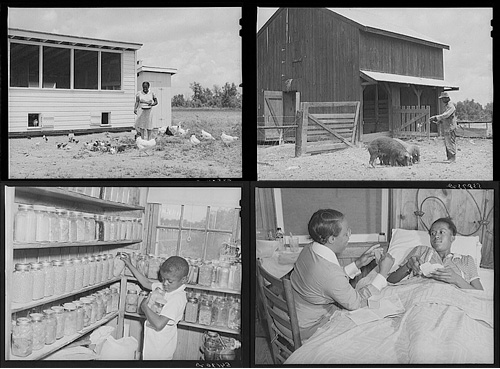 Photos by Marion Post Wolcott, June, 1940. Captions left to right, top to bottom. Violet Davenport with her chickens by new chicken house. La Delta Project, Thomastown, Louisiana. LC-USF34- 053824-D Clifton Davenport feeding some of his hogs by new barn. La Delta Project, Thomastown, Louisiana. LC-USF34- 053825-D FSA (Farm Security Administration) borrower's son getting some canned goods for dinner out of the pantry in his home. La Delta Project, Thomastown, Louisiana. LC-USF34- 054130-D Nurse Marguerite White Nurse Marguerite White treating a patient. La Delta Project, Thomastown, Louisiana. LC-USF34- 053873-D In another photo the patient is identified as Alice Jane Holden, a tuberculosis patient, and explains that the nurse is showing her how to make her own paper cups which can be burned after use in her home on La Delta Project. Thomastown, Louisiana. LC-USF34- 053890-D |
| We know that the concentration of people in one locale often has long-term consequences: Mileston Farm, an all-black project in Holmes County, Mississippi, was a center of movement activism in the 1960s, and the area south of Greenville that had a number of subdivided plantations retained its rural K-12 school and has become a magnet for working class whites [10] | 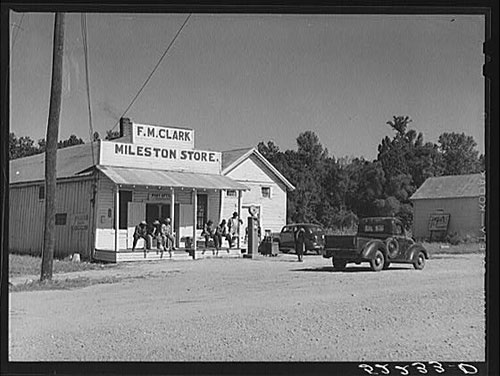 Mileston Plantation store and post office. Mileston, Mississippi Delta, Mississippi. Marion Post Wolcott, Oct. 1939. LC-USF34- 052233-D. Before project was established. Mileston Plantation store and post office. Mileston, Mississippi Delta, Mississippi. Marion Post Wolcott, Oct. 1939. LC-USF34- 052233-D. Before project was established. |
|
But the removals must have left a long shadow, as well. Scott (2001:92) writes that the people evicted from Transylvania left with a spirit of militancy that would produce many outstanding leaders in the struggle for civil rights in the 1960s, both in Lake Providence and down the road in Tallulah. … [E]verywhere they went, they carried a fighting spirit.We now know, as we continue our research, that we must ask what happened to the people who were removed. |
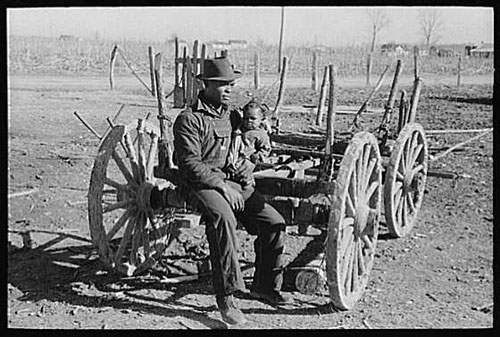 Negro sharecropper and child who will be resettled, Transylvania Project, Louisiana. Russell Lee, Jan. 1939. LC-USF33-011929-M2 |
| The legacy of the New Deal is a long one, and complicated. This is, in part, a cautionary tale for those who would reform the world, concerning the unintended consequences of their actions. | 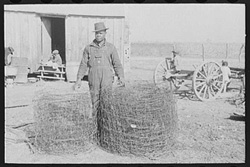 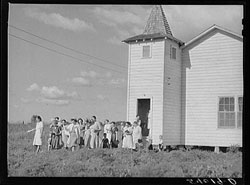 Negro sharecropper with wire which he has rolled up after taking down fences on his rented farm, Transylvania Project, Louisiana. Russell Lee. Jan. 1939. LC-USF33-011937-M4 The women's club leaving the church and community building after a home management demonstration by the supervisor and a baby shower they gave for Mrs. Verden Lee, one of their members. Transylvania Project, Louisiana. Marion Post Wolcott. June 1940. LC-USF34- 054019-D |
|
home | pg. 1 | pg. 2 | pg. 3 | pg. 4 | pg. 5 | pg. 6 | pg. 7 | pg. 8 | pg. 9 | pg. 10 | pg. 11 | notes | Map of FSA Projects | Transylvania detail 1 | Transylvania detail 2 | Wolcott detail | Bibliography |
|